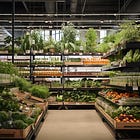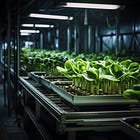For your convenience, an index for this series.
To recap our budget food forest series, we have focused on sourcing cheap/free plants and materials, as well as the ethics and philosophies behind these methods.
Now, we turn to a related question prompted from an internet discussion:
What is the fastest and cheapest way to kick start a food forest?
I often find that having fairly severe restrictions leads to creativity, and this speed-budget limitation is no different.
If you wanted to furnish a house as quickly as possible, you would need a whole team of carpenters to deliver quality bespoke furniture and a deep wallet to match. But if you compromise on “good enough”, then you just need a van hire, a few friends and a pizza weekend work party.
So this is what we’ll do. We’ll use capitalism’s great strength against itself to bootstrap our way to a near-future food forest. Once we’ve established a beachhead, we can have the luxury of taking our time.
I’m going to exploit hedging companies (no, not that type of hedge). I’m talking plants; companies whose sole purpose is to provide bulk quantities of ornamental hedging at low prices to decorate and protect business parks, road sides etc.
We’re looking to leverage the overlap in the Venn diagram of cheap hedging and food forest useful plants.
I’ve compiled a list below of plants I’ve spotted in real life ornamental settings (such as business parks or public road sides, and subsequently acquired for my own food forests. Nothing beats observation.
Before we begin, we might ask ourselves why some edible/medicinal trees have ended up in the hands of a bulk hedging companies. I think it’s an economics argument. Trees that have proven to be easy to propagate and tolerant of terrible conditions self-select their way into these company catalogues. In a way, it’s a depressingly market-driven version of Mark Shepard’s STUN technique
My idea is to plant these cheap but useful trees throughout your food forest, and save your time and money on a few more choice trees.
Enough dithering, let’s get to it.
11 Food Forest Trees that Hide in Hedge Catalogues
USDA hardiness zones indicate “long-term average annual extreme minimum temperature” whereas RHS Hardiness (H) gives the “absolute minimum winter temperatures”, consult this RHS reference.
1. Chokeberry
Aronia sp. - USDA 7, H7
I first spotted these at a campsite, protecting an ornamental lawn from desire paths towards the communal bathroom. Walk in right angles, damn it! I stuffed several handfuls into my pockets and added it to my breakfast yogurt. Delicious also in jams, medicinal herbal teas and more. Don’t let the vernacular name put you off; whilst astringent, you can work around it.
2. Alder
Alnus glutinosa - USDA 3, H7
Alder is able to fix nitrogen in its roots, so it works as a nurse tree that you plant close to a more precious tree, fertilising the soil around it. In practice, I believe that any nitrogen fixing tree will work as a nurse tree, but you must keep it pruned back! I have successfully trialled this method with Alder and tomatoes in my allotment.
3. Serviceberry
Amelanchier sp. - USDA 2, H7
I have experience in growing two species in this genus: A. canadensis and A. lamarckii. I will admit that I chose these at the time because they were the cheapest and tastiest fruit trees that could be found in bulk. As is the case for many in this list, they’ve been chosen by the hedging industry for ornamentation and hardiness, but they still taste pretty nice considering. They’ve not let me down yet, being planted in terrible and/or shallow soil. There are plenty of edible varieties to choose from.
4. Sea buckthorn
Hippophae rhamnoides - USDA 3, H7
Don’t plant this next to a footpath, especially if you have young children around. They have sharp thorns, though there are meant to be a few thornless varieties. Apart from this problem, Sea buckthorn fruit is meant to be incredibly nutritious and their legendary nitrogen fixing qualities lend to their hardiness in terrible soil. It makes sense that Sea buckthorn is a popular hedging plant.
I personally have experience with a cultivar called “Friesdorfer Orange”; purchased because it is self fertile, unlike the wild form.
5. Hazel
Corylus sp. - USDA 4, H7
Most will be familiar with hazels; they’re available at extraordinarily low prices in bulk. I like these because they’re very shade tolerant. Furthermore, I placed some saplings in terrible conditions - think of a tiny patch of shady soil between a paving slab and a fence - and they still put on 1m+ growth this year. There are so many uses for hazel.
6. Silverberry
Eleagnus sp. - USDA 2-9, H3-7
Elaegnus have a lot going for them; vigorous, nitrogen fixing and fruit producing (a rare combination). I have experience with Elaegnus umbelleta, but many hedging companies tend to sell Elaeagnus x ebbingei (Elaeagnus × submacrophylla since 2017) which is an F1 hybrid between E. macrophylla and E. pungens. Also known as Ebbing's Silverberry, it has another thing going for it: it is evergreen. I’m struggling to think of another plant that ticks all these check boxes.
7. Barberry
Berberis sp. syn. Mahonia sp. - USDA 3-8, H4-7
Barberries are a confusing bunch. Depending on who you talk to, they’re also known as Mahonias. I recently discovered that Mahonia is now just a synonym for Berberis, but old names have inertia. Darwin’s Barberry (Berberis darwinii) is a beloved of the hedging company world, but there are others. Their prickly nature, low growing habitat and tolerance to pruning go well with the landscaping world, but they also have acceptable fruit. The other common hedging barberry is the wonderfully named Oregeon Grape (Mahonia aquifolium syn. Berberis aquifolium). This plant is more upright, and has larger fruit.
In both cases, I find the fresh fruit a bit astringent; I think they’re much sweeter when dried, almost like raisins. The fruit in this genus contain Berberine.
8. Hawthorn
Crataegus monogyna - USDA 4-7, H5-7
How the mighty have fallen; once revered and cherished in cultures past, the Hawthorn tree is now sold in bulk to protect and ornament properties. It’s almost a duty by this point to plant some Hawthorn in your food forest to hark back to times past. With their beautiful flowers (not so good for smelling, but you can’t win them all), and dependable fruiting (unlike its cousin, the domesticated apple, Malus domestica), please consider this overlooked, venerable, tree.
People often denigrate the fruits of this tree, but their are many uses for it.
9. Elderberry
Sambucus sp. - USDA 5, H7
It’s an obvious choice, beautiful flowers, gorgeous scent, shade tolerance, high vigour, potent medicinal properties. I talked about this tree in a recent post.
10. Willow
Salix sp. - USDA 2-5, H7
When people talk about nitrogen fixing plants, willow never makes the cut. It should. You might not need to buy any willow for your food forest, just a willing host as they propagate easily from cuttings. I’ve been using a curly cultivar (unknown Salix species) to fertilise a small patch of summer squash, in a similar way to using alder to fertilise tomatoes.
11. Crab apple
Malus sp. - USDA 2-5, H7
In the UK at least, Malus sylvestris (European crab apple) is the most popular hedging tree. The wild form apparently has thorns, so you can see the attraction: ornamentation and protection in one. M. sylevestris is one of the wild forebears of the much fussier apple (M. domestica). The fruit can be used in similar ways to apples, but benefit from a nice frost. Like the thousands of apple cultivars, each European crab apple tree grown from seed will taste differently - you should try each crab apple if you grow these from seed as you might find one that can compete with the mighty apple.
Personally, I’m growing M. bacatta because I’m a sucker for any plant with the vernacular name containing the adjective “Siberian” - the performance so far has no disappointed.
12. Cherry Laurel
Prunus laurocerasus - USDA 6, H5
What’s this doing in a food forest list?! Cherry Laurel suffers a fair bit of my ire. There’s an established hedge of it on the other side of my fence. It overshadows my north facing bed that gets very little light anyway, and the thick root mat steals a lot of nutrient from any plants I’m trying to establish. It turns out that the fruit is edible and even popular:
Cherry laurel known as “karayemis”, “laz cherry” or “taflan”, is a popular evergreen racemes fruit in Turkey and some other Caucasus countries.
Invasiveness is a tricky subject, one which I won't delve into now. I decided to place Cherry Laurel into this list because I believe all plants can serve a purpose. Whilst you might not want to introduce Cherry Laurel, if you have a stand of it that you're thinking of destroying, consider keeping it pruned back for the fruit.

Final Thoughts
Apologies are in order to readers who aren’t in the UK. I wanted to write from practical experience. If you’re not in the UK, you can easily look up your regional hedging companies and see what edible plants they have in stock.
Each plant in this list deserves a whole article. I've only scratched the surface of their potential, preferences and habits - remember to do your own research!
A lot of these trees can be propagated from hard or softwood cuttings; no doubt another reason why they are so popular with hedge companies.
Some might think that we are stocking our hypothetical food forest with mediocre crops. However, there are at least twelve types of harvest here. There’s many ways to combine these crops together, even before adding in external sources. I don’t know about you, but I’d rather a a large harvest of “sub-par” fruit versus a small harvest of “higher quality” fruit. There’s always the possibility of grafting tastier varieties onto what is essentially a forest of hardy rootstocks!
A shout out to
. They recently talked about greening urban brownfield sites, and it’s fortuitous that I was writing a post about plants that are often used in these situations.With any luck, this article - and indeed, this entire series - has inspired you to stretch your food forest budget further.
Until next time.








Great way to approach similar challenges! Love the idea of a food forest taking up space in under utilized urban areas. 💚🙌🏽
Ah- so many species I dreamt about growing up reading gardening books from colder climates. We have functional equivalents here. Fruit and nut trees/shrubs rely on birds and mammals to carry their berries far and wide. There is no reason humans cannot substitute for the jackdaws and squirrels and spread these useful species far and wide.